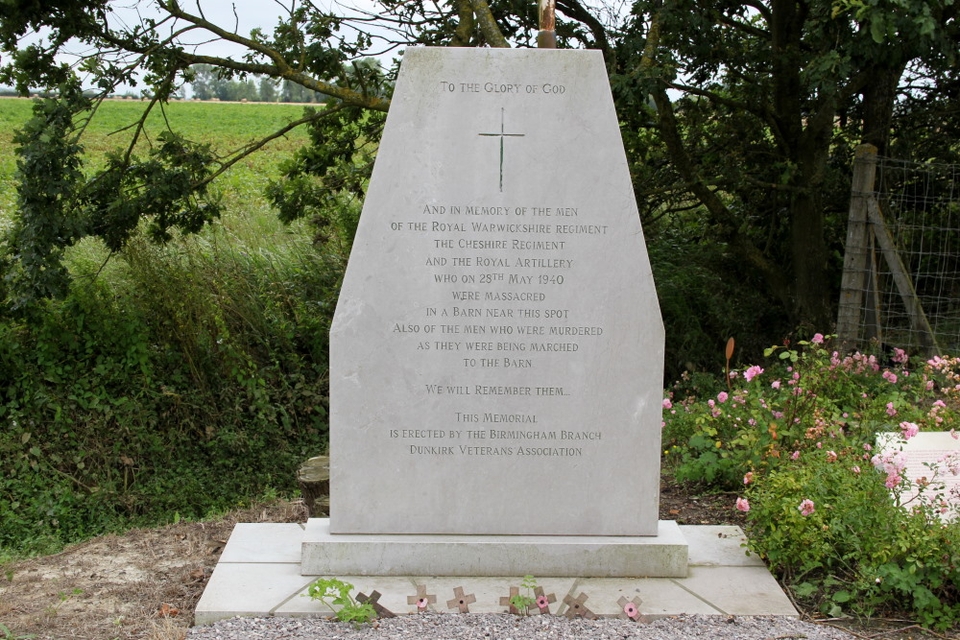
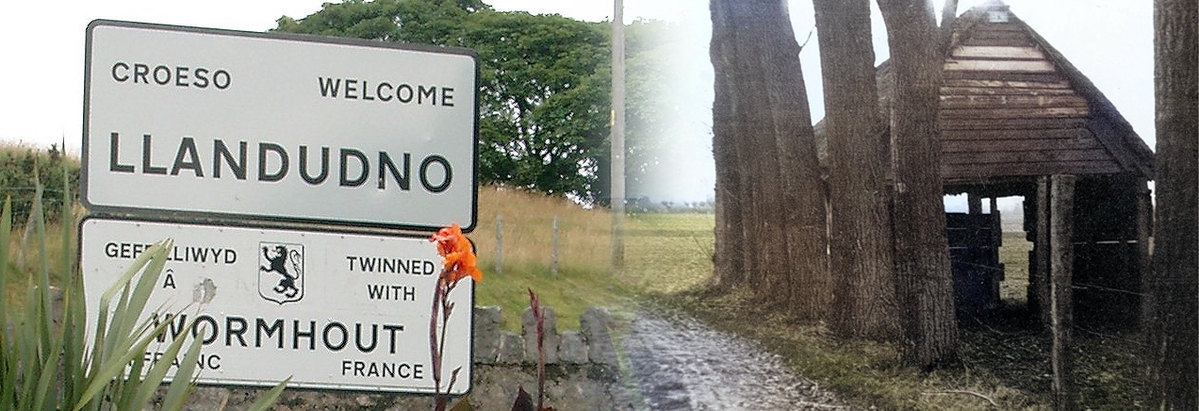
Downloads
Using the link below, you can download a copy of the Gift Aid form and both PDF and JPG versions of the notice below.

The Memorial
As far as it is known, there is no memorial in England or Wales specifically commemorating those who died in the Wormhout Massacre of 28 May 1940 nor is there a memorial in Llandudno commemorating the eight men of the town who lost their lives in or around Wormhout on that infamous day.
The year 2024 was the 100th Anniversary of the Dedication of the Memorial Chapel of Holy Trinity Church, which was specifically built to commemorate the fallen of the Great War. In order to mark this important anniversary, it was decided that a memorial to commemorate not only the eight Llandudno men caught up in the massacre, but all the soldiers who lost their lives in Wormhout that day.
The final form of the new memorial has not yet been approved by the church authorities. However, there are six windows in the north wall of the Memorial Chapel, five of which have stained glass and one, the one on the extreme left, has only plain glass. It is proposed that the new memorial should be of stained-glass in the left-hand window opening.
The existing five windows all show images of saints (from right to left): St. Tudno (patron saint of Llandudno), St. George (patron of a former parish church), St. David (patron saint of Wales), St. Cadwaladr (a king of Gwyedd), and St. Francis of Assisi. Church regulations require that any new stained-glass windows should conform with existing nearby windows.
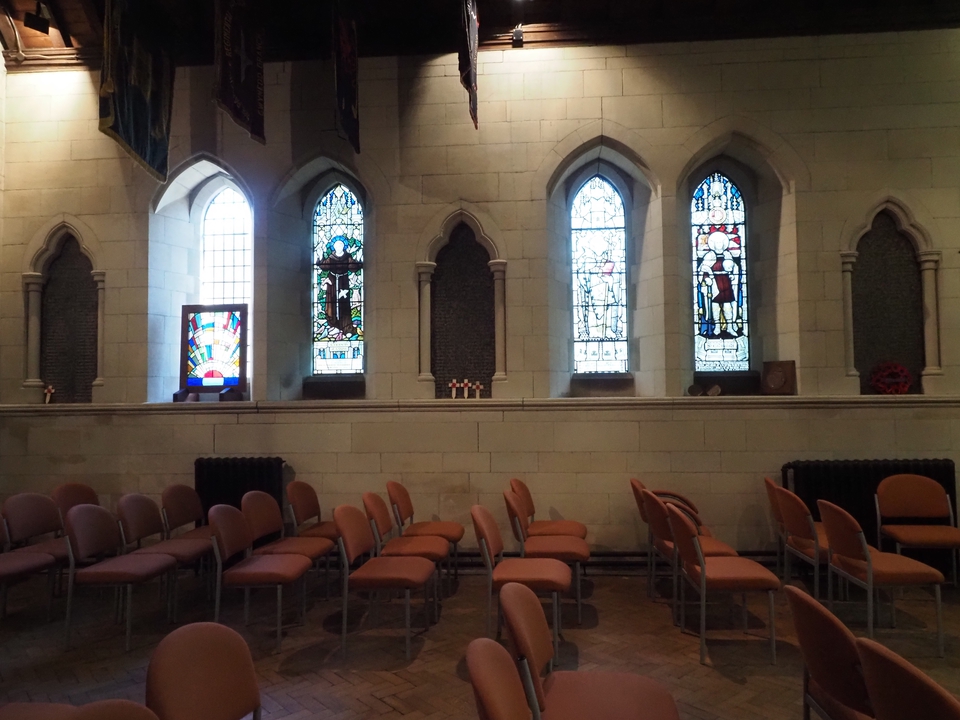
St. Winnoc
Perhaps the installation of St. Francis of Assisi in the 1950s indicated a shortage of suitable Welsh saints. However, there is one saint, reputedly of Welsh origin, who would grace our Chapel ideally: St. Winnoc, the Bishop of Flanders and Abbott of Wormhout (seventh century). The story goes that when Winnoc became feeble, he was relegated to the task of grinding corn. He was so pious in reading his scriptures that he neglected to grind the corn, but the corn got ground by divine inspiration. A monk, out of curiosity, took a peep and was struck blind – his blindness being cured by the saint.
Images of St. Winnoc show him with a corn-grinder of various styles and sizes. One such image can be seen in the window of St. Winnow’s (a corruption) in the village of the same name in Cornwall where he may have founded an oratory.
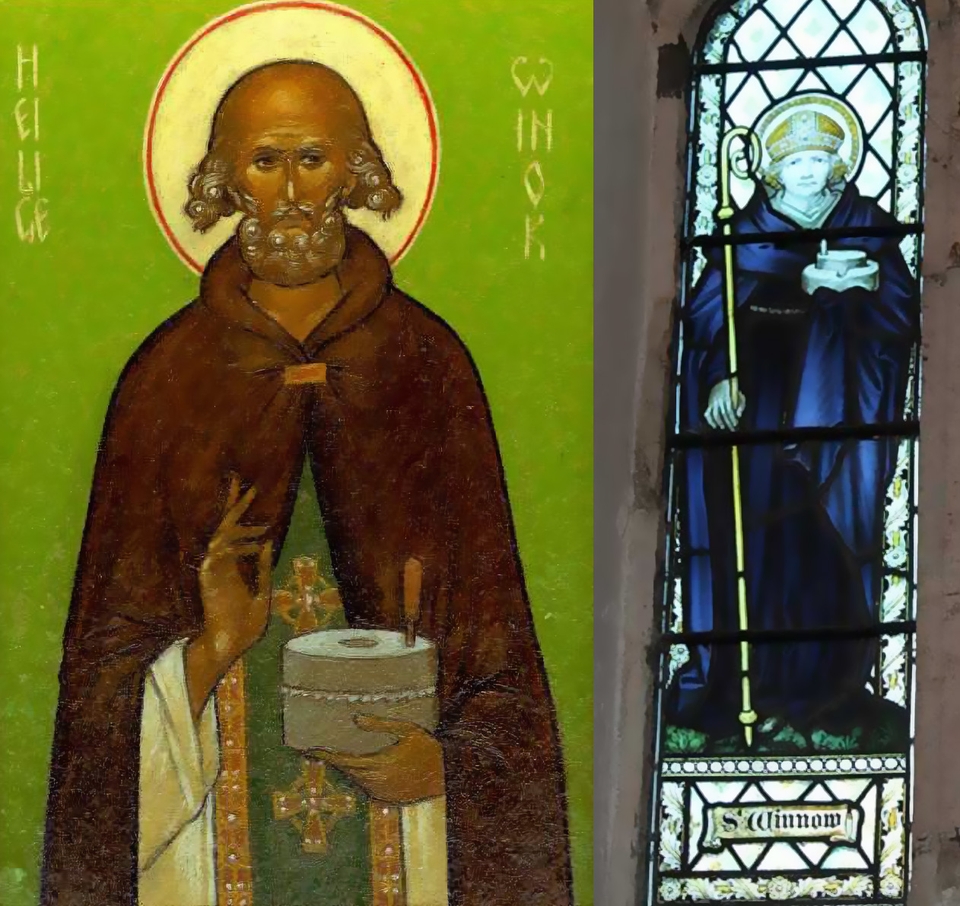
Existing Memorials in France
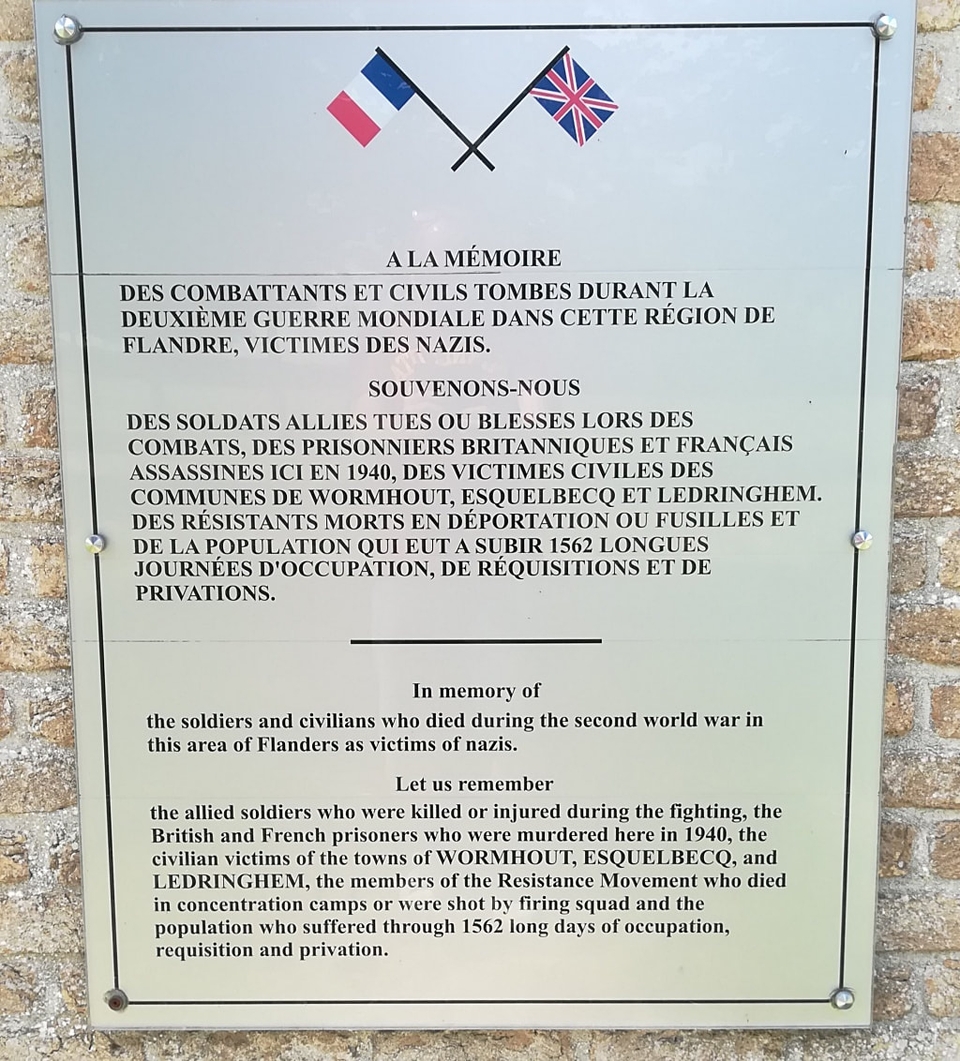
Estimated Cost – £10,000
Designs have yet to be drawn though they will be published on this page when available. However, the instructions will probably be for an image of St. Winnoc as well as the barn where the massacre took place.
The monument above was dedicated at a site near the barn at Esquelbecq in 1973. It reads:
TO THE GLORY OF GOD
AND IN MEMORY OF THE MEN
OF THE ROYAL WARWICKSHIRE REGIMENT
THE CHESHIRE REGIMENT
AND THE ROYAL ARTILLERY
WHO ON 28TH MAY 1940
WERE MASSACRED
IN A BARN NEAR THIS SPOT
ALSO OF THE MEN WHO WERE MURDERED
AS THEY WERE BEING MARCHED
TO THE BARN
WE WILL REMEMBER THEM
THIS MEMORIAL
IS ERECTED BY THE BIRMINGHAM BRANCH
DUNKIRK VETERANS ASSOCIATION
When this monument was erected, it was not known that at least six soldiers of 8th Royal Warwickshire Regiment were also amongst the prisoners.
Due to the road being widened, this monument is now located alongside the barn.
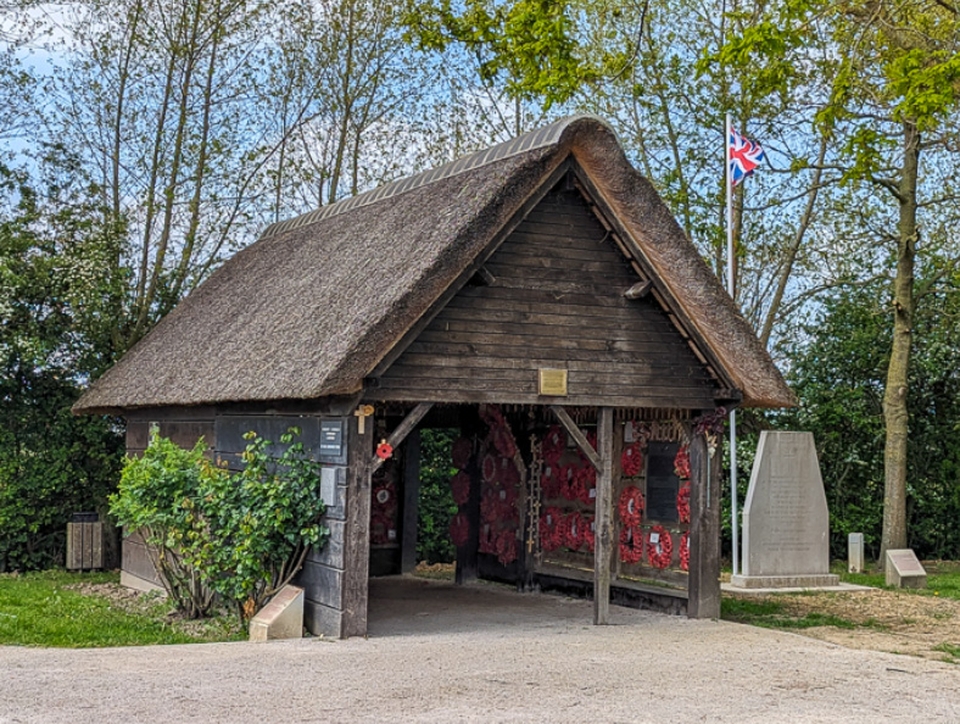
Prayer
O God of justice and compassion,
we give thanks for the courage and devotion of those from Llandudno who gave their lives
at Wormhout in May 1940.
As they stood firm in the face of cruelty and violence, may we remember them with honour,
and follow in the way of peace and reconciliation.
Grant them rest eternal, O Lord,
and commend them to the care of thy servants, Saint Tudno, who watched over them in life,
and Saint Winnoc, companion in their hour of trial.
May they rise in glory at the last trumpet, and behold the splendour of thy kingdom.
Through Jesus Christ our Lord,
who liveth and reigneth with thee and the Holy Spirit,
one God, now and for ever. Amen
Background
Introduction
If you live in or around Llandudno in North Wales, have you ever wondered why the main route in and out the town is known as “Wormhout Way”, or why Llandudno was twinned with this town in the Pas de Calais department of France in 1988?
Note: “Wormhout” is the spelling of the town since 1975; it was previously “Wormhoudt”.
The reason goes back to World War II in 1940 when the British Expeditionary Force was retreating in some disarray to the port of Dunkirk. As the Allied forces retreated, various units were instructed to “hold the line” to allow other units to fall back.
One of the units holding the line on 27 May 1940 between Ypres and Comines was the 69th Medium Regiment of the Royal Artillery with its 15 (the normal establishment was 16) BL 4.5-inch Mk1 medium guns with orders to shell the road between Ypres and Menin, opening fire at 21:00 hours, firing 1200 shells. After expending their ammunition, the gunners spiked their guns having been ordered to retreat to Dunkirk.
The 69th Medium Regiment, Royal Artillery
The 69th Medium Regiment RA was a newly-formed unit of the Territorial Army. It had its roots in the 61st (Carnarvonshire and Denbighshire Yeomanry) Medium Regiment RA which, because of a need to enlarge the army, formed a duplicate regiment in 1939, the 69th. Thereafter, the Llandudno gunners based at the Drill Hall on Argyll Road became D Troop of 242 Battery of the 69th Medium Regiment RA. After mobilisation, the regiment formed up at St. Asaph for training before heading south for Chipping Sodbury where it was located at the beginning of May 1940. It was here that the regiment was reinforced to bring it up to strength.The commander the 69th Medium Regiment was Lt Col John D'Arcy MC RA and the commander of 242 Battery was Captain Heneage Michael Charles Finch (known as Michael), the 9th Earl of Aylesford.
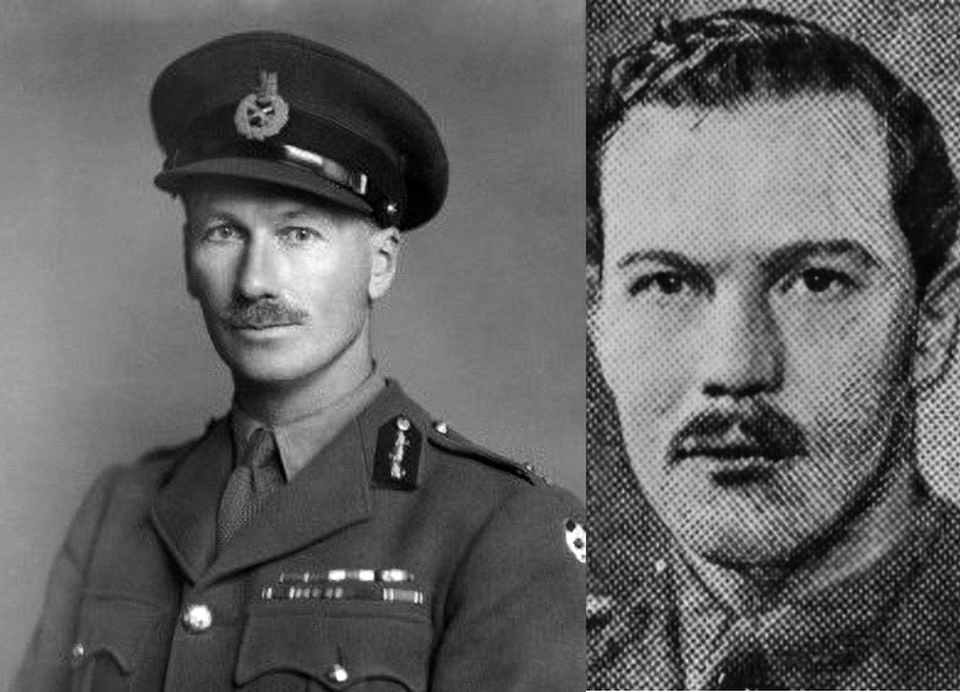
Unlike the 61st which had landed with BEF in France in September 1939, the 69th Regiment left Southampton on 8 May, landed at Le Havre and made its way north-east towards Belgium to face the advancing German Second Army Corps. By 16 May, the 69th was at the hamlet of La Couture in northern France where it received orders to become part of a defensive line along the River Scheldt (Escaut). A gunner of D Troop 242 Battery, Bernard Kitchener Jones was killed on 21 May. (He is buried in Ingoyghem Military Cemetery, about three miles north-west of the river.) According to the regiment's war diary, another gunner was wounded that day. That night, the regiment began a series of withdrawals which, by the morning of 27 May, found it in the region of La Clytte, 5 miles south-west of Ypres where it went into action for the last time. The following day, the regiment destroyed its guns and began a retreat to Dunkirk. The route ordered was direct: La Clytte, Rheninghelst, Poperinghe, Proven, Rousbrugge, Harbrugge, Cost Cappel, Rexpoed, Dunkirk – just under 30 miles.
Defending Wormhout
To the south of Dunkirk was another line of defence which ran south from Bergues via Wormhout to Cassel (the hashed red line pointed at by the large blue arrow below). Ordered to protect the town of Wormhout, 12 miles south of Dunkirk, and the surrounding area was the Territorial 48th (South Midland) Infantry Division. Infantry units within the division were the 8th Worcestershire Regiment and the 2nd Warwickshire Regiment, the latter being a regular battalion which had been swapped with a territorial battalion to strengthen the division. The 2nd Warwicks were ordered to defend Wormhout (less a company which had been withdrawn to defend the the DHQ at Bergues) whilst the 8th Worcestershire's were holding the eastern approaches to the town. In support were anti-tank gunners of the 53rd Royal Artillery (Worcestershire Yeomanry) and machine gunners of the 4th Cheshire Regiment. On 28 May 1940, the defenders at Wormhout, having run out of ammunition, surrendered to the Germans who were advancing from the south-west.
The Ambush
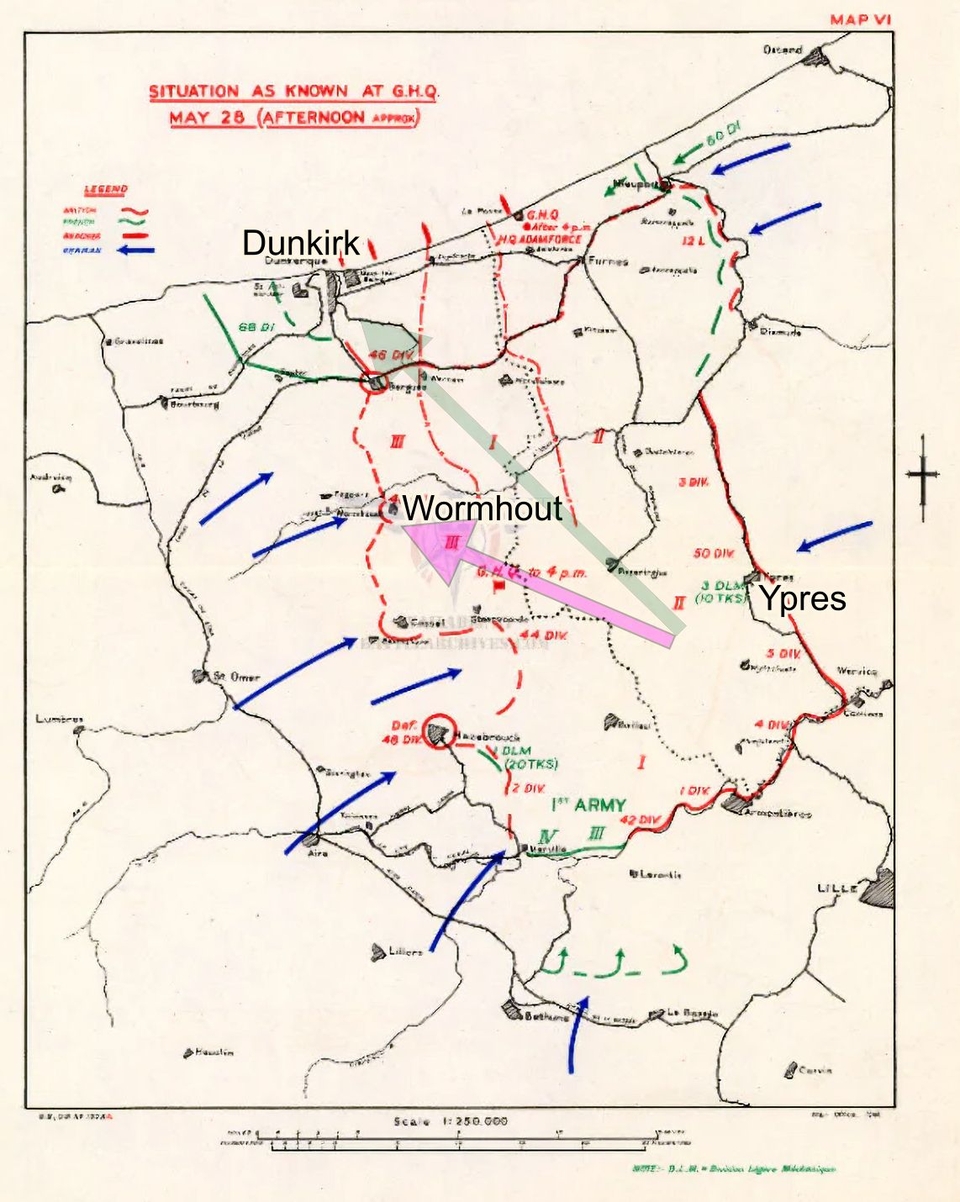
Coincidentally, to the rear of the retreating 2nd Infantry Division making for Dunkirk from around Ypres was D Troop of 242 Battery led by Captain Aylesford in its trucks. The enemy was advancing behind them from the east and to their left from the south-west. The scene was quite chaotic and, believing that Wormhout was still in British hands, Captain Finch made the fateful decision to divert west and enter the town from the south. Close to the Penne Becque, a small river running south to the north of Wormhout, he was riding in the lead truck of three when it was hit by a hail of fire from an approaching tank, killing Captain Aylesford and some gunners instantly. Those in the next two trucks, some 40 men, dived for cover, some evading the Germans and making it to Dunkirk though a number were captured and put “in the bag” with soldiers who had been defending the town. Accounts of the numbers of soldiers captured at that time vary – there were probably about 100 in total.
The Massacre
Those unlucky enough to have been taken prisoner had been captured by the Leibstandarte SS Adolf Hitler of the Waffen SS which, notoriously, did not take prisoners. They were marched to a barn near the hamlet of Esquelbecq, those wounded and unable to keep up being shot or bayoneted. The prisoners were herded into barn into which SS soldiers then threw grenades. Unsatisfied with the progress of their murder, the Germans took 10 prisoners in two groups of five and shot them. Still unsatisfied, the Germans machine-gunned those remaining in the barn and left them for dead. Amazingly, some estimated 15 survived though the many were to die of their wounds.
It is impossible to determine with accuracy which of the British soldiers to die that day were killed in action, shot during the march, or murdered in the barn. Some who survived were able to give details but the ultimate fate of many is unknown, including eight gunners from Llandudno of D Troop, 242 Battery:
Gunner Ronald Ashley
Gunner Vincent Kevin Barrie
Lance Serjeant Eric Stanley Beeton
Gunner Harold Bowen
Lance Bombardier John Coleman
Gunner Robert Edwards
Gunner George Morris
Bombardier Frank George Lally Thompson
Also murdered that day and discovered in a mass grave with British soldiers was a French soldier, Robert Vanpee.
The Testimony of Richard Parry
Richard Parry lived at Lloyd Street, Llandudno. He survived the massacre. Read his post-war testimony.
War Diary
The last paragraph of the 69th Medium Regiment RA’s War Diary for 28 May 1940 reads, “En route for DUNKIRK Capt the Earl of Aylesford with D Tp left the route to make a detour and ran into an enemy mobile force at WORMHOUDT. The Troop came under heavy fire and had to abandon their vehicles. Captain the Earl of Aylesford and 15 O.Rs are missing as a result of this encounter. 2/Lt. H.B. Dehn R.A. took command of the remainder of the Troop and managed to reach Dunkirk.”
What the war diary for that day does not record is the death of Gunner John Edward Blundell who, according to Commonwealth War Grave Commission records, died of wounds on 28 May 1940 and was interred at Kemmel Château Military Cemetery. The cemetery is less than 2 miles from De Klijte (La Clytte), the location of D Troop on the morning of that day. The only record of a gunner being wounded had been a week previously when the regiment was 30 miles to the east at Vichte. Perhaps the wounded John Blundell retreated with his regiment or perhaps he was with a unit of the medical services which was coincidently located nearby.
Aftermath
A book by the Rev Leslie Aitken Massacre on the Road to Dunkirk: Wormhout, 1940 (from which Richard Tudor Parry's statement was copied) chronicles the massacre in detail though mostly from the perspective of the Warwickshire Regiment. He identifies the SS officer who gave the orders to execute the prisoners as Hauptsturmführer Wilhelm Mohnke, the second in command of Leibstandarte SS Adolf Hitler. At the time, he was temporarily in charge of the division as its commander, Oberstgruppenführer Sepp Dietrich, had been pinned down by British fire and was sheltering in a ditch.

Wilhelm Mohnke died in 2001 aged 90 having never been charged with war crimes despite several attempts. This is in contrast to SS-Hauptsturmführer Fritz Knöchlein who was executed in 1949 for a similar crime carried out by the 14th Company, SS Division Totenkopf against around 100 soldiers of the 2nd Battalion of the Royal Norfolk Regiment on 27 May 1940, the day before the Wormhout Massacre, at Le Paradis, some 25 miles south south-east of Wormhout.

